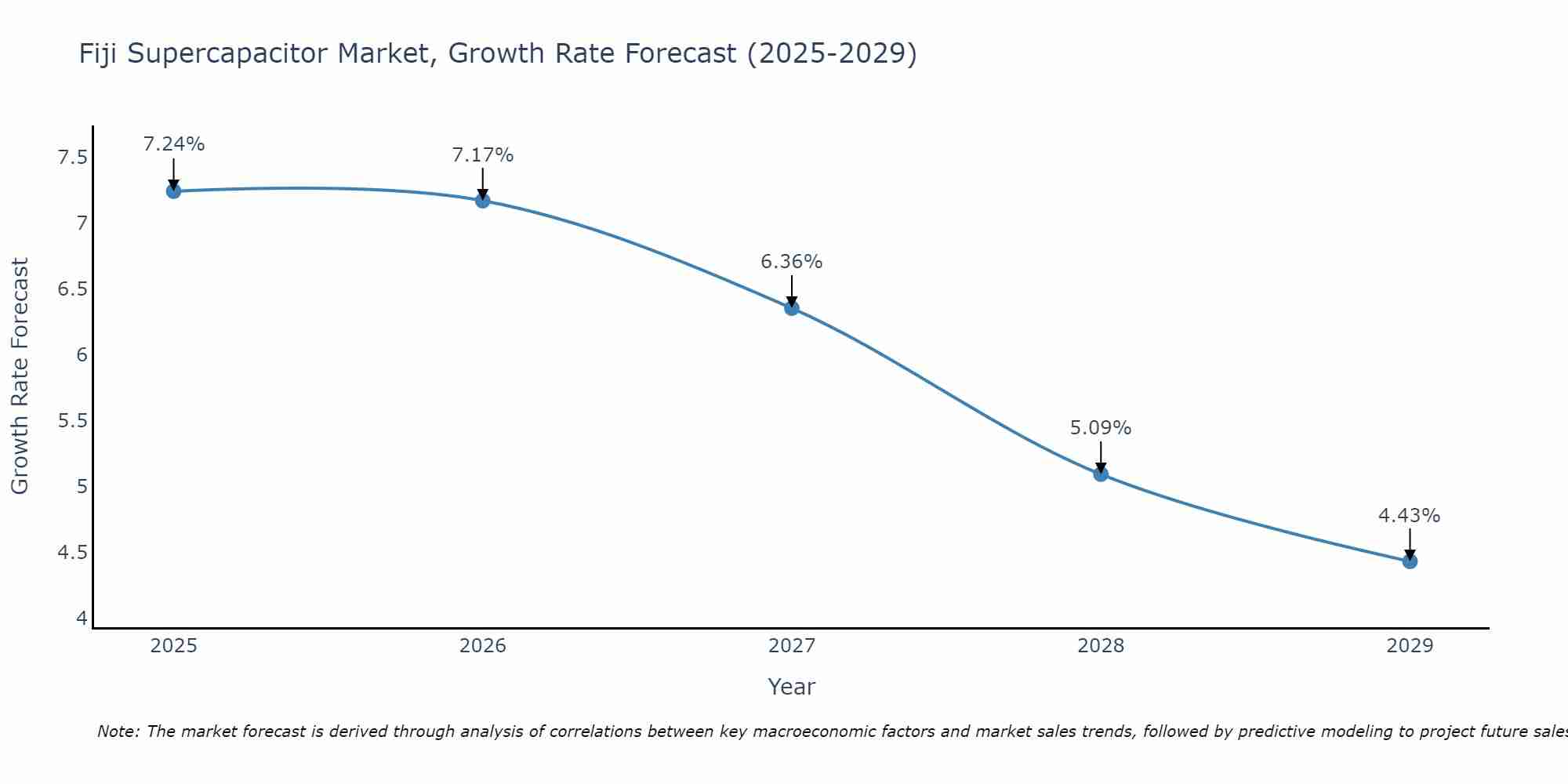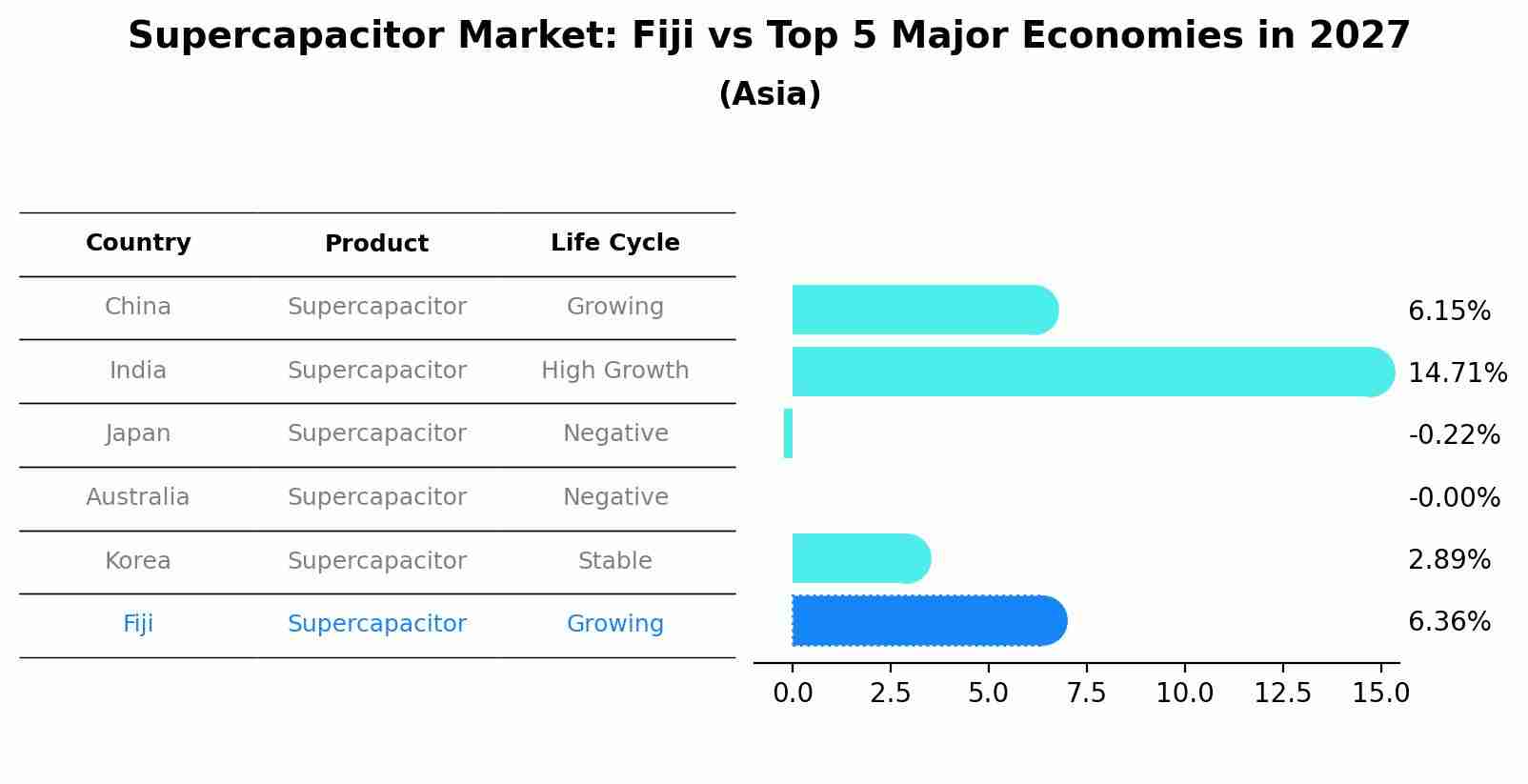Fiji Supercapacitor Market (2025-2031) | Share, Size, Segmentation, Industry, Revenue, Growth, Forecast, Companies, Trends, Analysis, Outlook & Value
| Product Code: ETC5139154 | Publication Date: Nov 2023 | Updated Date: Apr 2025 | Product Type: Market Research Report | |
| Publisher: 6Wresearch | Author: Bhawna Singh | No. of Pages: 60 | No. of Figures: 30 | No. of Tables: 5 |
Fiji Supercapacitor Market Size Growth Rate
The Fiji Supercapacitor Market may undergo a gradual slowdown in growth rates between 2025 and 2029. Starting high at 7.24% in 2025, the market steadily declines to 4.43% by 2029.

Supercapacitor Market: Fiji vs Top 5 Major Economies in 2027 (Asia)
By 2027, the Supercapacitor market in Fiji is anticipated to reach a growth rate of 6.36%, as part of an increasingly competitive Asia region, where China remains at the forefront, supported by India, Japan, Australia and South Korea, driving innovations and market adoption across sectors.

Fiji Supercapacitor Market Overview
The supercapacitor market in Fiji is gaining momentum as the country seeks advanced energy storage solutions for renewable energy integration and grid stabilization. Supercapacitors, known for their fast charging and high power density, are increasingly used in backup power systems and hybrid transportation. Support from international aid for sustainable energy projects is driving the markets growth.
Drivers of the market
The supercapacitor market in Fiji is growing as demand for efficient energy storage solutions increases in the automotive, renewable energy, and consumer electronics sectors. Supercapacitors are ideal for applications that require rapid energy discharge and recharge cycles, such as in electric vehicles (EVs) and energy storage systems. As Fiji aims to transition towards renewable energy, there is a growing interest in advanced energy storage technologies like supercapacitors, which provide fast response times and longer lifecycles. Furthermore, government policies promoting green technologies are also fueling market growth.
Challenges of the market
Fijis Supercapacitor Market faces challenges due to the countrys limited access to the advanced materials and technologies required for manufacturing supercapacitors. Supercapacitors are critical for energy storage solutions, but Fijis market is constrained by high import costs, limited R&D capabilities, and reliance on foreign suppliers. The energy infrastructure in Fiji is still developing, and the countrys small-scale demand for advanced energy storage technologies further inhibits the adoption of supercapacitors. There is also a lack of awareness regarding their benefits, which hinders their widespread use in both consumer electronics and renewable energy applications.
Government Policy of the market
Fiji`s energy security policies and efforts to modernize its infrastructure have led to increased interest in energy storage solutions, including supercapacitors. As part of its renewable energy transition, Fiji has made efforts to incorporate more sustainable energy storage systems to complement solar and other renewable energy sources. Policies promoting research into energy efficiency and technological development contribute to a growing market for supercapacitors in power grids, transportation, and other applications.
Key Highlights of the Report:
- Fiji Supercapacitor Market Outlook
- Market Size of Fiji Supercapacitor Market, 2024
- Forecast of Fiji Supercapacitor Market, 2031
- Historical Data and Forecast of Fiji Supercapacitor Revenues & Volume for the Period 2021-2031
- Fiji Supercapacitor Market Trend Evolution
- Fiji Supercapacitor Market Drivers and Challenges
- Fiji Supercapacitor Price Trends
- Fiji Supercapacitor Porter`s Five Forces
- Fiji Supercapacitor Industry Life Cycle
- Historical Data and Forecast of Fiji Supercapacitor Market Revenues & Volume By Type for the Period 2021-2031
- Historical Data and Forecast of Fiji Supercapacitor Market Revenues & Volume By Double Layered Capacitors for the Period 2021-2031
- Historical Data and Forecast of Fiji Supercapacitor Market Revenues & Volume By Pseudocapacitors for the Period 2021-2031
- Historical Data and Forecast of Fiji Supercapacitor Market Revenues & Volume By Hybrid Capacitors for the Period 2021-2031
- Historical Data and Forecast of Fiji Supercapacitor Market Revenues & Volume By Electrode Material for the Period 2021-2031
- Historical Data and Forecast of Fiji Supercapacitor Market Revenues & Volume By Carbon for the Period 2021-2031
- Historical Data and Forecast of Fiji Supercapacitor Market Revenues & Volume By Metal Oxide for the Period 2021-2031
- Historical Data and Forecast of Fiji Supercapacitor Market Revenues & Volume By Conducting Polymers for the Period 2021-2031
- Historical Data and Forecast of Fiji Supercapacitor Market Revenues & Volume By Composites for the Period 2021-2031
- Historical Data and Forecast of Fiji Supercapacitor Market Revenues & Volume By Application for the Period 2021-2031
- Historical Data and Forecast of Fiji Supercapacitor Market Revenues & Volume By Automotive for the Period 2021-2031
- Historical Data and Forecast of Fiji Supercapacitor Market Revenues & Volume By Energy for the Period 2021-2031
- Historical Data and Forecast of Fiji Supercapacitor Market Revenues & Volume By Consumer Electronics for the Period 2021-2031
- Historical Data and Forecast of Fiji Supercapacitor Market Revenues & Volume By Industrial for the Period 2021-2031
- Historical Data and Forecast of Fiji Supercapacitor Market Revenues & Volume By Aerospace for the Period 2021-2031
- Historical Data and Forecast of Fiji Supercapacitor Market Revenues & Volume By Medical for the Period 2021-2031
- Fiji Supercapacitor Import Export Trade Statistics
- Market Opportunity Assessment By Type
- Market Opportunity Assessment By Electrode Material
- Market Opportunity Assessment By Application
- Fiji Supercapacitor Top Companies Market Share
- Fiji Supercapacitor Competitive Benchmarking By Technical and Operational Parameters
- Fiji Supercapacitor Company Profiles
- Fiji Supercapacitor Key Strategic Recommendations
Frequently Asked Questions About the Market Study (FAQs):
1 Executive Summary |
2 Introduction |
2.1 Key Highlights of the Report |
2.2 Report Description |
2.3 Market Scope & Segmentation |
2.4 Research Methodology |
2.5 Assumptions |
3 Fiji Supercapacitor Market Overview |
3.1 Fiji Country Macro Economic Indicators |
3.2 Fiji Supercapacitor Market Revenues & Volume, 2021 & 2031F |
3.3 Fiji Supercapacitor Market - Industry Life Cycle |
3.4 Fiji Supercapacitor Market - Porter's Five Forces |
3.5 Fiji Supercapacitor Market Revenues & Volume Share, By Type, 2021 & 2031F |
3.6 Fiji Supercapacitor Market Revenues & Volume Share, By Electrode Material, 2021 & 2031F |
3.7 Fiji Supercapacitor Market Revenues & Volume Share, By Application, 2021 & 2031F |
4 Fiji Supercapacitor Market Dynamics |
4.1 Impact Analysis |
4.2 Market Drivers |
4.3 Market Restraints |
5 Fiji Supercapacitor Market Trends |
6 Fiji Supercapacitor Market Segmentations |
6.1 Fiji Supercapacitor Market, By Type |
6.1.1 Overview and Analysis |
6.1.2 Fiji Supercapacitor Market Revenues & Volume, By Double Layered Capacitors, 2021-2031F |
6.1.3 Fiji Supercapacitor Market Revenues & Volume, By Pseudocapacitors, 2021-2031F |
6.1.4 Fiji Supercapacitor Market Revenues & Volume, By Hybrid Capacitors, 2021-2031F |
6.2 Fiji Supercapacitor Market, By Electrode Material |
6.2.1 Overview and Analysis |
6.2.2 Fiji Supercapacitor Market Revenues & Volume, By Carbon, 2021-2031F |
6.2.3 Fiji Supercapacitor Market Revenues & Volume, By Metal Oxide, 2021-2031F |
6.2.4 Fiji Supercapacitor Market Revenues & Volume, By Conducting Polymers, 2021-2031F |
6.2.5 Fiji Supercapacitor Market Revenues & Volume, By Composites, 2021-2031F |
6.3 Fiji Supercapacitor Market, By Application |
6.3.1 Overview and Analysis |
6.3.2 Fiji Supercapacitor Market Revenues & Volume, By Automotive, 2021-2031F |
6.3.3 Fiji Supercapacitor Market Revenues & Volume, By Energy, 2021-2031F |
6.3.4 Fiji Supercapacitor Market Revenues & Volume, By Consumer Electronics, 2021-2031F |
6.3.5 Fiji Supercapacitor Market Revenues & Volume, By Industrial, 2021-2031F |
6.3.6 Fiji Supercapacitor Market Revenues & Volume, By Aerospace, 2021-2031F |
6.3.7 Fiji Supercapacitor Market Revenues & Volume, By Medical, 2021-2031F |
7 Fiji Supercapacitor Market Import-Export Trade Statistics |
7.1 Fiji Supercapacitor Market Export to Major Countries |
7.2 Fiji Supercapacitor Market Imports from Major Countries |
8 Fiji Supercapacitor Market Key Performance Indicators |
9 Fiji Supercapacitor Market - Opportunity Assessment |
9.1 Fiji Supercapacitor Market Opportunity Assessment, By Type, 2021 & 2031F |
9.2 Fiji Supercapacitor Market Opportunity Assessment, By Electrode Material, 2021 & 2031F |
9.3 Fiji Supercapacitor Market Opportunity Assessment, By Application, 2021 & 2031F |
10 Fiji Supercapacitor Market - Competitive Landscape |
10.1 Fiji Supercapacitor Market Revenue Share, By Companies, 2024 |
10.2 Fiji Supercapacitor Market Competitive Benchmarking, By Operating and Technical Parameters |
11 Company Profiles |
12 Recommendations | 13 Disclaimer |
- Single User License$ 1,995
- Department License$ 2,400
- Site License$ 3,120
- Global License$ 3,795
Search
Thought Leadership and Analyst Meet
Our Clients
Related Reports
- Germany Breakfast Food Market (2026-2032) | Industry, Share, Growth, Size, Companies, Value, Analysis, Revenue, Trends, Forecast & Outlook
- Australia Briquette Market (2025-2031) | Growth, Size, Revenue, Forecast, Analysis, Trends, Value, Share, Industry & Companies
- Vietnam System Integrator Market (2025-2031) | Size, Companies, Analysis, Industry, Value, Forecast, Growth, Trends, Revenue & Share
- ASEAN and Thailand Brain Health Supplements Market (2025-2031) | Strategy, Consumer Insights, Analysis, Investment Trends, Opportunities, Growth, Size, Share, Industry, Revenue, Segments, Value, Segmentation, Supply, Forecast, Restraints, Outlook, Competition, Drivers, Trends, Demand, Pricing Analysis, Competitive, Strategic Insights, Companies, Challenges
- ASEAN Bearings Market (2025-2031) | Strategy, Consumer Insights, Analysis, Investment Trends, Opportunities, Growth, Size, Share, Industry, Revenue, Segments, Value, Segmentation, Supply, Forecast, Restraints, Outlook, Competition, Drivers, Trends, Demand, Pricing Analysis, Competitive, Strategic Insights, Companies, Challenges
- Europe Flooring Market (2025-2031) | Outlook, Share, Industry, Trends, Forecast, Companies, Revenue, Size, Analysis, Growth & Value
- Saudi Arabia Manlift Market (2025-2031) | Outlook, Size, Growth, Trends, Companies, Industry, Revenue, Value, Share, Forecast & Analysis
- Uganda Excavator, Crane, and Wheel Loaders Market (2025-2031) | Strategy, Consumer Insights, Analysis, Investment Trends, Opportunities, Growth, Size, Share, Industry, Revenue, Segments, Value, Segmentation, Supply, Forecast, Restraints, Outlook, Competition, Drivers, Trends, Demand, Pricing Analysis, Competitive, Strategic Insights, Companies, Challenges
- Rwanda Excavator, Crane, and Wheel Loaders Market (2025-2031) | Strategy, Consumer Insights, Analysis, Investment Trends, Opportunities, Growth, Size, Share, Industry, Revenue, Segments, Value, Segmentation, Supply, Forecast, Restraints, Outlook, Competition, Drivers, Trends, Demand, Pricing Analysis, Competitive, Strategic Insights, Companies, Challenges
- Kenya Excavator, Crane, and Wheel Loaders Market (2025-2031) | Strategy, Consumer Insights, Analysis, Investment Trends, Opportunities, Growth, Size, Share, Industry, Revenue, Segments, Value, Segmentation, Supply, Forecast, Restraints, Outlook, Competition, Drivers, Trends, Demand, Pricing Analysis, Competitive, Strategic Insights, Companies, Challenges
Industry Events and Analyst Meet
Whitepaper
- Middle East & Africa Commercial Security Market Click here to view more.
- Middle East & Africa Fire Safety Systems & Equipment Market Click here to view more.
- GCC Drone Market Click here to view more.
- Middle East Lighting Fixture Market Click here to view more.
- GCC Physical & Perimeter Security Market Click here to view more.
6WResearch In News
- Doha a strategic location for EV manufacturing hub: IPA Qatar
- Demand for luxury TVs surging in the GCC, says Samsung
- Empowering Growth: The Thriving Journey of Bangladesh’s Cable Industry
- Demand for luxury TVs surging in the GCC, says Samsung
- Video call with a traditional healer? Once unthinkable, it’s now common in South Africa
- Intelligent Buildings To Smooth GCC’s Path To Net Zero


















